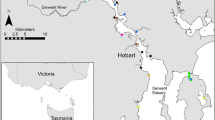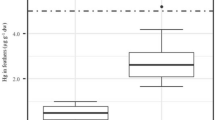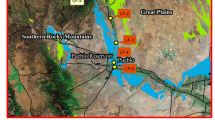Abstract
Several trace metals and metalloids have been introduced into aquatic ecosystems due to anthropogenic activities. Some of these elements like mercury (in the form of methylmercury) are easily transferred from one trophic level to another and can accumulate to toxic quantities in organisms at the top of aquatic food webs. For this reason, seabirds like the eastern brown pelican (Pelecanus occidentalis carolinensis) are susceptible to heavy metal and metalloid toxicity and may warrant periodic monitoring. Mercury, cadmium, copper, arsenic, and selenium were measured in the feathers of adult brown pelicans and chicks in several breeding colonies (Shamrock Island, Chester Island, Marker 52 Island, North Deer Island, Raccoon Island, Felicity Island, Gaillard Island, Audubon Island, and Ten Palms Island) in the northern Gulf of Mexico. Overall, most chicks and adults examined had mercury levels in feathers that were below the concentration range in which birds show symptoms of mercury toxicity. However, chicks in the Audubon Island and Ten Palms Island colonies displayed mercury levels that were 3 times higher than values observed in 5 other colonies. In addition, several adults and chicks displayed selenium concentrations that are above what is considered safe for birds. Cadmium quantities in feathers were below levels that trigger toxicity in birds. Similarly, arsenic measurements were at quantities below the average of what has been reported for birds living in contaminated sites. Finally, we identify pelican breeding colonies that may warrant monitoring due to elevated levels of contaminants.



Similar content being viewed by others
Data availability
The dataset for this work can be accessed through the Gulf of Mexico Research Initiative Information and Data Cooperative (GRIIDC) (GRIIDC DOI: https://doi.org/10.7266/aza38gzz).
References
Ackerman, J. T., Takekawa, J. Y., Eagles-Smith, C. A., & Iverson, S. A. (2008). Mercury contamination and effects on survival of American avocet and black-necked stilt chicks in San Francisco Bay. Ecotoxicology, 17(2), 103–116. https://doi.org/10.1007/s10646-007-0164-y.
Apeti, D. A., Lauenstein, G. G., & Evans, D. W. (2012). Recent status of total mercury and methyl mercury in the coastal waters of the northern Gulf of Mexico using oysters and sediments from NOAA’s mussel watch program. Marine Pollution Bulletin, 64(11), 2399–2408. https://doi.org/10.1016/j.marpolbul.2012.08.006.
Bouton, S. N., Frederick, P. C., Spalding, M. G., & McGill, H. (1999). Effects of chronic, low concentrations of dietary methylmercury on the behavior of juvenile great egrets. Environmental Toxicology and Chemistry, 18(9), 1934–1939. https://doi.org/10.1002/etc.5620180911.
Burger, J. (1993). Metals in avian feathers: Bioindicators of environmental pollution. Reviews in environmental toxicology, 5, 203–311.
Burger, J., & Gochfeld, M. (1997). Risk, mercury levels, and birds: Relating adverse laboratory effects to field biomonitoring. Environmental Research, 75(2), 160–172. https://doi.org/10.1006/enrs.1997.3778.
Burger, J., Nisbet, I. C., & Gochfeld, M. (1994). Heavy metal and selenium levels in feathers of known-aged common terns (Sterna hirundo). Archives of Environmental Contamination and Toxicology, 26(3), 351–355. https://doi.org/10.1007/bf00203562.
Burger, J., Tsipoura, N., Niles, L. J., Gochfeld, M., Dey, A., & Mizrahi, D. (2015). Mercury, Lead, cadmium, arsenic, chromium and selenium in feathers of shorebirds during migrating through Delaware Bay, New Jersey: Comparing the 1990s and 2011/2012. Toxics, 3(1), 63–74. https://doi.org/10.3390/toxics3010063.
Carvalho, P. C., Bugoni, L., McGill, R. A. R., & Bianchini, A. (2013). Metal and selenium concentrations in blood and feathers of petrels of the genus procellaria. Environmental Toxicology and Chemistry, 32(7), 1641–1648. https://doi.org/10.1002/etc.2204.
Chiou, P. W.-S., Chen, K.-L., & Yu, B. (1997). Effects of roxarsone on performance, toxicity, tissue accumulation and residue of eggs and excreta in laying hens. Journal of the Science of Food and Agriculture, 74(2), 229–236. https://doi.org/10.1002/(SICI)1097-0010(199706)74:2<229::AID-JSFA793>3.0.CO;2-F.
Esdaile, L. J., & Chalker, J. M. (2018). The mercury problem in artisanal and small-scale gold mining. Chemistry, 24(27), 6905–6916. https://doi.org/10.1002/chem.201704840.
Evers, D. (2018). The effects of methylmercury on wildlife: A comprehensive review and approach for interpretation. In D. A. Dellasala & M. I. Goldstein (Eds.), Encyclopedia of the Anthropocene (pp. 181–194). Oxford: Elsevier.
Franson, J. C., Lahner, L. L., Meteyer, C. U., & Rattner, B. A. (2012). Copper pellets simulating oral exposure to copper ammunition: Absence of toxicity in American kestrels (Falco sparverius). Archives of Environmental Contamination and Toxicology, 62(1), 145–153. https://doi.org/10.1007/s00244-011-9671-1.
Frederick, P., & Jayasena, N. (2011). Altered pairing behaviour and reproductive success in white ibises exposed to environmentally relevant concentrations of methylmercury. Proceedings of the Biological Sciences, 278(1713), 1851–1857. https://doi.org/10.1098/rspb.2010.2189.
Ganther, H. E., & Sunde, M. L. (1974). Effect of tuna fish and selenium on the toxicity of methylmercury: A progress report. Journal of Food Science, 39(1), 1–5. https://doi.org/10.1111/j.1365-2621.1974.tb00974.x.
Haney, J. C., Geiger, H. J., & Short, J. W. (2014). Bird mortality from the Deepwater Horizon oil spill. II. Carcass sampling and exposure probability in the coastal Gulf of Mexico. Marine Ecology Progress Series, 513, 239–252.
Henderson, B. M., & Winterfield, R. W. (1975). Acute copper toxicosis in the Canada goose. Avian Diseases, 19(2), 385–387.
Hoffman, D. J., Spalding, M. G., & Frederick, P. C. (2005). Subchronic effects of methylmercury on plasma and organ biochemistries in great egret nestlings. Environmental Toxicology and Chemistry, 24(12), 3078–3084. https://doi.org/10.1897/04-570.1.
Holm, G. O., Hess, T. J., Justic, D., McNease, L., Linscombe, R. G., & Nesbitt, S. A. (2003). Population recovery of the eastern brown pelican following its extirpation in Louisiana. The Wilson Bulletin, 115(4), 431–437.
Huge, D. H., Rauschenberger, R. H., Wieser, F. M., & Hemming, J. M. (2011). A comparison of mercury burdens between St. Marks National Wildlife Refuge and St. Andrew bay, Florida: Evaluation of fish body burdens and physiological responses in largemouth bass, spotted seatrout, striped mullet, and sunfish. Open-File Report. Reston, VA.
Jodice, P. G. R., Adams, E. M., Lamb, J. S., & Satgé, Y. G. (2019). Strategic avian monitoring plan for the Gulf of Mexico: Seabirds. In M. S. Woodrey, A. M. V. Fournier, J. S. Gleason, J. E. Lyons, & R. R. Wilson (Eds.), Strategic Avian Monitoring Plan for the Gulf of Mexico: Mississippi State University press. Mississippi: Starkville.
King, K. A., Flickinger, E. L., & Hildebrand, H. H. (1977). The decline of brown pelicans on the Louisiana and Texas Gulf Coast. Southwestern Naturalist, 21(4), 417–431.
King, K. A., Blankinship, D., Payne, E., Krynitsky, A., & Hensler, G. (1985). Brown pelican populations and pollutants in Texas 1975-1981. The Wilson Bulletin, 97(2), 201–214.
King, D. T., Goatcher, B. L., Fischer, J. W., Stanton, J., Lacour, J. M., Lemmons, S. C., et al. (2013). Home ranges and habitat use of brown pelicans (Pelecanus occidentalis) in the northern Gulf of Mexico. Waterbirds: The International Journal of Waterbird Biology, 36(4), 494–500.
Lamb, J. S., Jodice, P. G. R., & Satgé, Y. G. (2017a). Diet composition and provisioning rates of nestlings determine reproductive success in a subtropical seabird. Marine Ecology Progress Series, 581, 149–164. https://doi.org/10.3354/meps12301.
Lamb, J. S., Satgé, Y. G., & Jodice, P. G. R. (2017b). Influence of density-dependent competition on foraging and migratory behavior of a subtropical colonial seabird. Ecology and Evolution, 7(16), 6469–6481. https://doi.org/10.1002/ece3.3216.
Lamb, J. S., Newstead, D. J., Koczur, L. M., Ballard, B. M., Green, M. C., & Jodice, P. G. R. (2018). A bridge between oceans: Overland migration of marine birds in a wind energy corridor. Journal of Avian Biology, 49(2), jav-01474. https://doi.org/10.1111/jav.01474.
Martin, R., Dowling, K., Pearce, D., Sillitoe, J., & Florentine, S. (2014). Health effects associated with inhalation of airborne arsenic arising from mining operations. Geosciences, 4(3). https://doi.org/10.3390/geosciences4030128.
Mason, R. P., Laporte, J. M., & Andres, S. (2000). Factors controlling the bioaccumulation of mercury, methylmercury, arsenic, selenium, and cadmium by freshwater invertebrates and fish. Archives of Environmental Contamination and Toxicology, 38(3), 283–297. https://doi.org/10.1007/s002449910038.
Matthiessen, P., Reed, J., & Johnson, M. (1999). Sources and potential effects of copper and zinc concentrations in the estuarine waters of Essex and Suffolk, United Kingdom. Marine Pollution Bulletin, 38(10), 908–920. https://doi.org/10.1016/S0025-326X(99)00090-9.
Mohammed, E., Mohammed, T., & Mohammed, A. (2017). Optimization of an acid digestion procedure for the determination of Hg, As, Sb, Pb and Cd in fish muscle tissue. MethodsX, 4, 513–523. https://doi.org/10.1016/j.mex.2017.11.006.
Ndu, U., Christensen, G. A., Rivera, N. A., Gionfriddo, C. M., Deshusses, M. A., Elias, D. A., & Hsu-Kim, H. (2018). Quantification of mercury bioavailability for methylation using diffusive gradient in thin-film samplers. Environmental Science & Technology, 52(15), 8521–8529. https://doi.org/10.1021/acs.est.8b00647.
Newtoff, K. N., & Emslie, S. D. (2017). Mercury exposure and diet in brown pelicans (Pelecanus occidentalis) in North Carolina, USA. Waterbirds, 40(1), 50–57 58.
Oliver, L. M., Fisher, W. S., Winstead, J. T., Hemmer, B. L., & Long, E. R. (2001). Relationships between tissue contaminants and defense-related characteristics of oysters (Crassostrea virginica) from five Florida bays. Aquatic Toxicology, 55(3), 203–222. https://doi.org/10.1016/S0166-445X(01)00161-8.
Ottinger, M. A., Maness, T., Grace, J. K., Wilson, R., & Jodice, P. G. R. (2019). Gulf of Mexico avian monitoring network strategic monitoring plan: Avian health assessments. In M. S. Woodrey, A. M. V. Fournier, J. S. Gleason, J. E. Lyons, & R. R. Wilson (Eds.), Strategic Avian Monitoring Plan for the Gulf of Mexico: Mississippi State University press. Mississippi: Starkville.
Parízek, J., & Ostádalová, I. (1960). The protective effect of small amounts of selenite in sublimate intoxication. Experientia, 23, 142–143.
Parks, J. M., Johs, A., Podar, M., Bridou, R., Hurt Jr., R. A., Smith, S. D., et al. (2013). The genetic basis for bacterial mercury methylation. Science, 339(6125), 1332–1335. https://doi.org/10.1126/science.1230667.
Peterson, S. A., Ralston, N. V. C., Whanger, P. D., Oldfield, J. E., & Mosher, W. D. (2009). Selenium and mercury interactions with emphasis on fish tissue. Environmental Bioindicators, 4(4), 318–334. https://doi.org/10.1080/15555270903358428.
Renedo, M., Bustamante, P., Tessier, E., Pedrero, Z., Cherel, Y., & Amouroux, D. (2017). Assessment of mercury speciation in feathers using species-specific isotope dilution analysis. Talanta, 174, 100–110. https://doi.org/10.1016/j.talanta.2017.05.081.
Ruelas-Inzunza, J., Hernández-Osuna, J., & Páez-Osuna, F. (2009). Organic and total mercury in muscle tissue of five aquatic birds with different feeding habits from the SE Gulf of California, Mexico. Chemosphere, 76(3), 415–418. https://doi.org/10.1016/j.chemosphere.2009.03.042.
Sanchez-Virosta, P., Espin, S., Garcia-Fernandez, A. J., & Eeva, T. (2015). A review on exposure and effects of arsenic in passerine birds. Sci Total Environ, 512-513, 506–525. https://doi.org/10.1016/j.scitotenv.2015.01.069.
Schartup, A. T., Thackray, C. P., Qureshi, A., Dassuncao, C., Gillespie, K., Hanke, A., & Sunderland, E. M. (2019). Climate change and overfishing increase neurotoxicant in marine predators. Nature, 572, 648–650. https://doi.org/10.1038/s41586-019-1468-9.
Scheuhammer, A. M. (1987). The chronic toxicity of aluminium, cadmium, mercury, and lead in birds: A review. Environmental Pollution, 46(4), 263–295. https://doi.org/10.1016/0269-7491(87)90173-4.
Solonen, T., & Lodenius, M. (1984). Mercury in Finnish sparrowhawks Accipiter nisus. Ornis Fenn., 61, 58–63.
Spallholz, J. E., & Hoffman, D. J. (2002). Selenium toxicity: Cause and effects in aquatic birds. Aquatic Toxicology, 57(1), 27–37. https://doi.org/10.1016/S0166-445X(01)00268-5.
Streets, D. G., Lu, Z., Levin, L., Ter Schure, A. F. H., & Sunderland, E. M. (2018). Historical releases of mercury to air, land, and water from coal combustion. Sci Total Environ, 615, 131–140. https://doi.org/10.1016/j.scitotenv.2017.09.207.
Szymczykv, K., & Zalewski, K. (2003). Copper, zinc, lead and cadmium content in liver and muscles of mallards (Anas Platyrhychnos) and other hunting fowl species in Warmia and Mazury in 1999-2000. Polish Journal of Environmental Studies, 12(3), 381–386.
Thompson, D. R., & Furness, R. W. (1989). Comparison of the levels of total and organic mercury in seabird feathers. Marine Pollution Bulletin, 20(11), 577–579. https://doi.org/10.1016/0025-326X(89)90361-5.
Torres, Z., Mora, M. A., Taylor, R. J., Alvarez-Bernal, D., Buelna, H. R., & Hyodo, A. (2014). Accumulation and hazard assessment of mercury to waterbirds at Lake Chapala, Mexico. Environmental Science & Technology, 48(11), 6359–6365. https://doi.org/10.1021/es4048076.
Varekamp, J. C., & Buseck, P. R. (1986). Global mercury flux from volcanic and geothermal sources. Applied Geochemistry, 1(1), 65–73. https://doi.org/10.1016/0883-2927(86)90038-7.
Whanger, P. D. (1985). Metabolic interactions of selenium with cadmium, mercury, and silver. In H. H. Draper (Ed.), Advances in Nutritional Research (Vol. 7, pp. 221–250).
White, D. H., & Finley, M. T. (1978). Uptake and retention of dietary cadmium in mallard ducks. Environmental Research, 17(1), 53–59. https://doi.org/10.1016/0013-9351(78)90060-9.
Yan, R., Gauthier, D., Flamant, G., Peraudeau, G., Lu, J., & Zheng, C. (2001). Fate of selenium in coal combustion: Volatilization and speciation in the flue gas. Environmental Science & Technology, 35(7), 1406–1410. https://doi.org/10.1021/es0001005.
Young, D. R., Alexander, G. V., & McDermott-Ehrlich, D. (1979). Vessel-related contamination of Southern California harbours by copper and other metals. Marine Pollution Bulletin, 10(2), 50–56. https://doi.org/10.1016/0025-326X(79)90269-8.
Funding
This study was supported by the Bureau of Ocean Energy Management and US Geological Survey (Interagency Agreement # M12PG00014). Funding from the Harte Research Institute was used to conduct all chemical analysis. Any use of trade, firm, or product names is for descriptive purposes only and does not imply endorsement by the US Government.
Author information
Authors and Affiliations
Corresponding author
Ethics declarations
Conflict of interest
The authors declare that they have no conflict of interest.
Ethical approval
Field research was conducted with permission from the Clemson University Animal Care and Use Committee (2017-008). Permitting for field data collection was provided by the US Geological Survey Bird Banding Lab (22408) and South Carolina Department of Natural Resources (BB-18-22).
Additional information
Publisher’s note
Springer Nature remains neutral with regard to jurisdictional claims in published maps and institutional affiliations.
Electronic supplementary material
ESM 1
(PDF 108 kb)
Rights and permissions
About this article
Cite this article
Ndu, U., Lamb, J., Janssen, S. et al. Mercury, cadmium, copper, arsenic, and selenium measurements in the feathers of adult eastern brown pelicans (Pelecanus occidentalis carolinensis) and chicks in multiple breeding grounds in the northern Gulf of Mexico. Environ Monit Assess 192, 286 (2020). https://doi.org/10.1007/s10661-020-8237-y
Received:
Accepted:
Published:
DOI: https://doi.org/10.1007/s10661-020-8237-y




